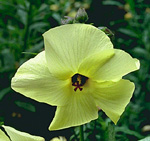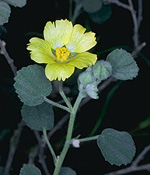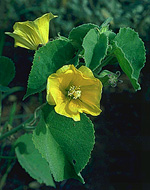 |
This is a large and important cosmopolitan family, widespread (although never dominant) in Australia in most open communities (although in rainforests restricted to edges and disturbed sites). Most species are tropical or arid, but some introduced species are found in disturbed sites in temperate regions.
Characteristic features of the family Malvaceae in Australia include: - herbs or soft-wooded shrubs or trees, often with stellate hairs
- leaves alternate, often palmately veined or lobed
- flowers vary from small to very large and showy, often with an epicalyx of bracts below the calyx
- petals 5, distinctively spirally overlapping (convolute), pink, yellow, red or white, often each with a dark basal blotch
- stamens numerous, often united into a column in the centre of the flower with anthers arising at many levels
- fruit a capsule, often flat-topped and splitting radially at the apex, or the whole fruit splitting radially into 1-seeded articles
Description
Evergreen trees, or shrubs, or annual or perennial terrestrial herbs. Perennating by taproots. Vegetative reproduction absent or by root suckers. Extra-floral nectaries absent, or on the foliage. Internal secretions not obvious. Plants with simple, dendritic, stellate, clavate, capitate or vesicular glandular or non-glandular, uniseriate or multiseriate hairs, or with peltate scales. Leaves well developed or much reduced (i.e. to scales, etc), alternate and spiral, cauline if herbs, petiolate or subsessile. Stipules rarely absent, distinct and free from the petiole, green and leafy or bristle-like, falling off early or persistent. Lamina simple, symmetric or conspicuously asymmetric, pinnatifid or pinnatisect or palmatifid or palmatisect or bipinnatifid or tripinnatifid, etc; lamina/segments filiform, acicular, subulate, linear, lanceolate, ovate, elliptic, oblanceolate, ovate, oblong, flabellate, orbicular or reniform; base cuneate, attenuate, rounded, cordate, hastate, sagittate or oblique; margins entire, dentate, crenate or serrate, ±flat; venation pinnate, or palmate, with the midrib conspicuous, and the tertiary venation reticulate or without conspicuous cross-veins; surfaces not punctate; herbaceous. Male and female flowers occurring on separate plants, or with all the flowers bisexual. Inflorescences terminal or axillary, consisting of spikes, panicles, cymes or solitary flowers. Bracts present. Bracteoles present or absent. Pollination by insects or birds. Flowers odourless or fragrant, sessile or stalked. Floral disc absent; nectaries absent or present on the perianth. Perianth regular, of 2 dissimilar whorls. Epicalyx usually present and calyx-like, with 3–5 (–12) segments. Calyx segments free or fused, with 5 sepals or lobes, valvate in bud; calyx cup-shaped, bell-shaped or urn-shaped. Corolla segments free, with 5 petals, alternating with the sepals or calyx lobes, imbricate in bud, white, cream, yellow, orange, red, pink, magenta, purple or violet, without contrasting markings, or streaked, spotted, etc, membranous; claws absent; lobes ±entire or notched, emarginate, bifid or bilobed. Fertile stamens numerous, alternating with, or opposite to, or without a clear correlation with the sepals or calyx lobes, at least partly fused to the corolla, free of the ovary and style, fused by their filaments into an open or closed tube, all ±equal. Anthers dorsifixed, versatile or not versatile, opening sideways or inwards by longitudinal slits; 1-celled. Ovary superior and sessile. Carpels (2–) 5–15 (–20), fused; ovary with (2–) 5–15 (–20) locules. Style single and unbranched, or branched above, or branching from the base, terminal. Ovules 1–numerous per locule, stalked; placentation axile. Fruit dry, dehiscent or schizocarpic; a loculicidal capsule, or a schizocarp forming mericarps of various types; the perianth on the maturing fruit deciduous or dry and persistent. Disseminule macro-surface featureless or with straight hairs or spines; micro-surface ±smooth, spinulose, tuberculate, muricate, reticulate or rugose, orange, brown or grey, glossy or dull. Seeds 1–numerous per fruit. Aril absent. Cotyledons 2. Embryo curved.
(Note: this description has been generated from the coded data compiled for the key. Any errors in the key data will be reflected in the descriptions.)
A treatment of the family Malvaceae has not yet been published in the Flora of Australia. It will appear in Volume 7.
Australian genera of Malvaceae (as recognised for the Flora of Australia)
† = some species native, others introduced
* = all species introduced
Abelmoschus
†Abutilon
*Alcea
Althaea
Alyogyne
*Anoda
Asterotrichion
Decaschistia
Gossypium
Gynatrix
Herissantia
†Hibiscus
Howittia
Lagunaria
†Lavatera
Lawrencia
Macrostelia
Malachra
*Malva
*Malvastrum
Malvella
*Modiola
†Pavonia
Radyera
Sida
Thespesia
Urena

|
  |

Abelmoschus manihot (flower)
Photo: D.Greig © ANBG

Abutilon halophilum (flower)
Photo: M.Fagg © ANBG

Abutilon leucopetalum (flowers)
Photo: A.Urban © A.Urban

Abutilon micropetalum (flower)
Photo: H.Nicholson © H. & N. Nicholson

|

| |